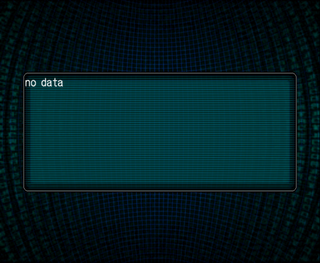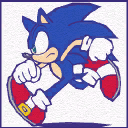Phantasy Star Online Episode I&II
| Phantasy Star Online Episode I&II |
|---|
|
Developer: Sonic Team
|
| This game's online features are no longer supported. While this game's online features were once accessible, they are (as of March 30, 2007) no longer officially supported and online-exclusive features may be documented as now-unseen content. |
Phantasy Star Online Episode I&II is the game that enabled homebrew. By mimicking the game's server program, one could supply their own executable codes to the GameCube. Early dumps of GameCube disc images were created using this game. Nintendo and Sega responded by releasing Phantasy Star Online Episode I&II Plus.
Contents
Unused Graphics
All unused art is found in both the original release and Plus.

The title screen from the Japanese Trial Version of the game is present in all GameCube PSO builds, including Episode III. The title screen exists in both English and Japanese, although the Trial Version was never released outside of Japan.

A file called f256_joyboot.gvm is present in all PSO GameCube releases (including Episode III), which references a feature called "N-Port". "N-Port" is a set of games that can be downloaded from a GameCube to a Game Boy Advance console.
Memory card file images
GameCube memory card files have a small icon and a larger banner, which are shown in the system menu's memory card manager.
There are six types of save files in PSO: the system file, the character file, the Guild Card file, the snapshot file, download quest files, and the network information file. There is a set of icons for these file types, but the network information file uses an animated icon from a different set instead.
There is also a full set of banners for each file type, but the game uses only one of the banners for all file types. The used banner (top) has a slightly larger logo and the "Episode I & II" text was added.
Action icons
These sheets contain the icons used in the Customize menu and action palette. The fourth icon in the top row doesn't appear anywhere in the game, nor does the gray icon next to the "Do not touch the Memory Card" text.
Unused splash screens
The file containing these images is named ending.gvm, so they may have been shown at some point after completing an Episode. They don't appear anywhere in the final game.
Dreamcast Leftovers
The game also has some leftover assets from the Dreamcast version, including a promotional image from the Sega GameJam demo of Phantasy Star Online Version 2 (2001).
Unused Menu
There is one very simple unused menu type in the game. This menu type corresponds to the error box that appeared in the Trial Edition if you didn't have a modem, but its text was deleted (probably because it was never translated to English), so it now just says this:
Debug Mode
A large quantity of strings in the final game suggest that one or more debug modes are present.
The following strings are related to manipulating enemies. Several settings appear to be assigned to specific enemies:
STATE : NORMAL STATE : DEAD STATE : FALLEN START NUM : %2d TOTAL NUM : %2d GROUP:%2d L/M:LEADER L/M:MEMBER RAG-LAPPY AL-LAPPY TYPE:IN FIGHTER TYPE:OUT FIGHTER TYPE:UNKOWN TYPE:LOW APPEAR TYPE:HIGH APPEAR APPEAR SPEED(+1.f Min:0.01f) NEEDLE SPEED(+6.f Min:1.f) MIRAGE:ENABLE MIRAGE:DISABLE TEX:GOLD TEX:NORMAL STELTH:ENABLE STELTH:DISABLE APPEAR:GROUND APPEAR:ROOF TECNIQ ATTACK % (+0.4f) STELTH ON % STELTH OFF %
The following strings suggest the presence of a model viewer, as well as player location and area warp-related test features:
EVT NO : %d MODEL SELECT <- SELECT COLOR <- MODEL SELECT SwitchMode:ON->ON SwitchMode:ON->OFF SwitchID:%3d Param No LINK : ON LINK : OFF SELECT TYPE NORMAL SELECT TYPE VR SELECT TYPE CTRL CENTER GOVERNOR CITY LABO <- DST POS X <- DST POS Y <- DST POS Z <- DST ANG Y <- MODEL TYPE <- MESSAGE : %s <- NEXT STAGE No.%d <- KEY ID : %d <- SELECT A MODEL <- DAMAGE POWER <- ENEMY NUMBER <- MOTION TEST ERROR
The test texture used by TIndirectEditor in Episode III is present here as well, but the code for TIndirectEditor was removed from the final build of Episodes I & II.
Unused Music
Some music that is not used in-game.
Early Central Control Area
An early version of Jungle A Lush Load.
Early Seabed
An early version of Abysmal Ball Intermission.
The Phantasy Star series
| |
|---|---|
| Master System | Phantasy Star |
| Genesis | Phantasy Star II (Localization Prototype) • Phantasy Star III: Generations of Doom • Phantasy Star IV: The End of the Millennium (Localization Prototypes) |
| PlayStation 2 | Sega Ages 2500 Series Vol. 17: Phantasy Star generation:2 • Sega Ages 2500 Series Vol. 32: Phantasy Star Complete Collection |
| Phantasy Star Online | |
| Dreamcast | Phantasy Star Online |
| GameCube | Phantasy Star Online Episode I&II • Phantasy Star Online Episode III: C.A.R.D. Revolution (Prototype) |
| PlayStation 2 | Phantasy Star Universe |
| Nintendo DS | Phantasy Star 0 |
| PlayStation Portable | Phantasy Star Portable • Phantasy Star Portable 2 |
| PlayStation Vita | Phantasy Star Nova |
| Xbox 360 | Phantasy Star Universe |
| Windows | Phantasy Star Online • Phantasy Star Universe • Phantasy Star Online 2 • Phantasy Star Online 2: New Genesis |
- Pages missing developer references
- Games developed by Sonic Team
- Pages missing publisher references
- Games published by Sega
- GameCube games
- Pages missing date references
- Games released in 2002
- Games released in September
- Games released on September 12
- Games released in October
- Games released on October 29
- Games with hidden development-related text
- Games with unused graphics
- Games with unused music
- Defunct online content
- Phantasy Star series
Cleanup > Pages missing date references
Cleanup > Pages missing developer references
Cleanup > Pages missing publisher references
Games > Defunct online content
Games > Games by content > Games with hidden development-related text
Games > Games by content > Games with unused graphics
Games > Games by content > Games with unused music
Games > Games by developer > Games developed by Sega > Games developed by Sonic Team
Games > Games by platform > GameCube games
Games > Games by publisher > Games published by Sega
Games > Games by release date > Games released in 2002
Games > Games by release date > Games released in October
Games > Games by release date > Games released in October > Games released on October 29
Games > Games by release date > Games released in September
Games > Games by release date > Games released in September > Games released on September 12
Games > Games by series > Phantasy Star series








